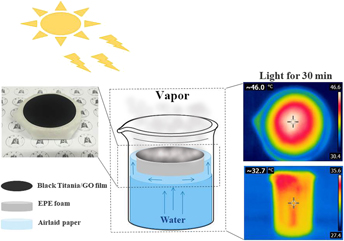Crossref Citations
This article has been cited by the following publications. This list is generated based on data provided by
Crossref.
Li, Yuxin
Fu, Rong
Wang, Xiangdong
and
Guo, Xiaoling
2018.
Preparation of core–shell nanostructured black nano-TiO2 by sol–gel method combined with Mg reduction.
Journal of Materials Research,
Vol. 33,
Issue. 24,
p.
4173.
Liu, Xinghang
Cheng, Haiyan
Guo, Zhenzhen
Zhan, Qian
Qian, Jingwen
and
Wang, Xianbao
2018.
Bifunctional, Moth-Eye-Like Nanostructured Black Titania Nanocomposites for Solar-Driven Clean Water Generation.
ACS Applied Materials & Interfaces,
Vol. 10,
Issue. 46,
p.
39661.
Cao, Sisi
Jiang, Qisheng
Wu, Xuanhao
Ghim, Deoukchen
Gholami Derami, Hamed
Chou, Ping-I.
Jun, Young-Shin
and
Singamaneni, Srikanth
2019.
Advances in solar evaporator materials for freshwater generation.
Journal of Materials Chemistry A,
Vol. 7,
Issue. 42,
p.
24092.
Lim, Jin Soo
and
Kim, Gunn
2019.
First-principles modeling of water permeation through periodically porous graphene derivatives.
Journal of Colloid and Interface Science,
Vol. 538,
Issue. ,
p.
367.
Elsheikh, Ammar H.
Sharshir, Swellam W.
Ahmed Ali, Mohamed Kamal
Shaibo, J.
Edreis, Elbager M.A.
Abdelhamid, Talaat
Du, Chun
and
Haiou, Zhang
2019.
Thin film technology for solar steam generation: A new dawn.
Solar Energy,
Vol. 177,
Issue. ,
p.
561.
Tao, Fujun
Green, Michael
Garcia, Alma Valenzuela
Xiao, Ting
Van Tran, Anh Thi
Zhang, Yuliang
Yin, Yansheng
and
Chen, Xiaobo
2019.
Recent progress of nanostructured interfacial solar vapor generators.
Applied Materials Today,
Vol. 17,
Issue. ,
p.
45.
Ahmed, Farah Ejaz
Hashaikeh, Raed
and
Hilal, Nidal
2019.
Solar powered desalination – Technology, energy and future outlook.
Desalination,
Vol. 453,
Issue. ,
p.
54.
Tian, Mengkun
Liu, Chenze
Ge, Jingxuan
Geohegan, David
Duscher, Gerd
and
Eres, Gyula
2019.
Recent progress in characterization of the core–shell structure of black titania.
Journal of Materials Research,
Vol. 34,
Issue. 07,
p.
1138.
Hamad, Hesham
Bailón-García, Esther
Maldonado-Hódar, Francisco J.
Pérez-Cadenas, Agustín F.
Carrasco-Marín, Francisco
and
Morales-Torres, Sergio
2019.
Synthesis of TixOy nanocrystals in mild synthesis conditions for the degradation of pollutants under solar light.
Applied Catalysis B: Environmental,
Vol. 241,
Issue. ,
p.
385.
Xu, You
Yin, Jiacheng
Wang, Jun
and
Wang, Xianbao
2019.
Design and optimization of solar steam generation system for water purification and energy utilization: A review.
REVIEWS ON ADVANCED MATERIALS SCIENCE,
Vol. 58,
Issue. 1,
p.
226.
Bahman, Mona
AlNahyan, Maryam
Mustafa, Ibrahim
and
AlMarzooqi, Faisal
2019.
Effect of Pore Characteristics in Polyvinylidene Fluoride/Fumed Silica Membranes on Mass Flux in Solar-Assisted Evaporation Applications.
Applied Sciences,
Vol. 9,
Issue. 15,
p.
3186.
Peng, Guilong
Deng, Shichen
Sharshir, Swellam W.
Ma, Dengke
Kabeel, A.E.
and
Yang, Nuo
2020.
High efficient solar evaporation by airing multifunctional textile.
International Journal of Heat and Mass Transfer,
Vol. 147,
Issue. ,
p.
118866.
Xu, You
Wang, Jun
Yu, Fang
Guo, Zhenzhen
Cheng, Haiyan
Yin, Jiacheng
Yan, Lei
and
Wang, Xianbao
2020.
Flexible and Efficient Solar Thermal Generators Based on Polypyrrole Coated Natural Latex Foam for Multimedia Purification.
ACS Sustainable Chemistry & Engineering,
Vol. 8,
Issue. 32,
p.
12053.
Pang, Yunsong
Zhang, Jiajia
Ma, Ruimin
Qu, Zhiguo
Lee, Eungkyu
and
Luo, Tengfei
2020.
Solar–Thermal Water Evaporation: A Review.
ACS Energy Letters,
Vol. 5,
Issue. 2,
p.
437.
Tao, Fujun
Valenzuela Garcia, Alma
Xiao, Ting
Zhang, Yuliang
Yin, Yansheng
and
Chen, Xiaobo
2020.
Interfacial Solar Vapor Generation: Introducing Students to Experimental Procedures and Analysis for Efficiently Harvesting Energy and Generating Vapor at the Air–Water Interface.
Journal of Chemical Education,
Vol. 97,
Issue. 4,
p.
1093.
Wang, Lingling
Wang, Min
Xu, Zhongping
Yu, Wei
and
Xie, Huaqing
2020.
Well oil dispersed Au/oxygen-deficient TiO2 nanofluids towards full spectrum solar thermal conversion.
Solar Energy Materials and Solar Cells,
Vol. 212,
Issue. ,
p.
110575.
Liu, Xinghang
Mishra, Debesh Devadutta
Wang, Xianbao
Peng, Hongyan
and
Hu, Chaoquan
2020.
Towards highly efficient solar-driven interfacial evaporation for desalination.
Journal of Materials Chemistry A,
Vol. 8,
Issue. 35,
p.
17907.
Zhang, Linjiang
Bai, Bo
Hu, Na
and
Wang, Honglun
2020.
Efficient 3D-interfacial solar steam generation enabled by photothermal nanodiamonds paint-coat with optimized heat management.
Applied Thermal Engineering,
Vol. 171,
Issue. ,
p.
115059.
Kashyap, Varun
and
Ghasemi, Hadi
2020.
Solar heat localization: concept and emerging applications.
Journal of Materials Chemistry A,
Vol. 8,
Issue. 15,
p.
7035.
Alsharief, Arwa
Mustafa, Ibrahim
AlNahyan, Maryam
Alnaqbi, Wafa
and
Almarzooqi, Faisal
2020.
CNT–PVDF freestanding sheets for direct solar evaporation toward continuous desalination applications.
Journal of Materials Science,
Vol. 55,
Issue. 7,
p.
2860.





